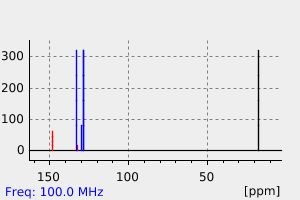1-苯基-3,4-二甲基膦杂环戊二烯) | 30540-36-4
中文名称
1-苯基-3,4-二甲基膦杂环戊二烯)
中文别名
1-苯基-3,4-二甲基膦杂环戊二烯
英文名称
1-phenyl-3,4-dimethylphosphole
英文别名
3,4-dimethyl-1-phenylphosphole;3,4-dimethyl-1-phenyl-1H-phosphole
CAS
30540-36-4
化学式
C12H13P
mdl
——
分子量
188.209
InChiKey
ACKPJROCIAWGID-UHFFFAOYSA-N
BEILSTEIN
——
EINECS
——
-
物化性质
-
计算性质
-
ADMET
-
安全信息
-
SDS
-
制备方法与用途
-
上下游信息
-
文献信息
-
表征谱图
-
同类化合物
-
相关功能分类
-
相关结构分类
计算性质
-
辛醇/水分配系数(LogP):1.9
-
重原子数:13
-
可旋转键数:1
-
环数:2.0
-
sp3杂化的碳原子比例:0.17
-
拓扑面积:0
-
氢给体数:0
-
氢受体数:0
SDS
上下游信息
-
下游产品
中文名称 英文名称 CAS号 化学式 分子量 —— 1-phenyl-2-bromo-3,4-dimethylphosphole 146440-99-5 C12H12BrP 267.105
反应信息
-
作为反应物:描述:1-苯基-3,4-二甲基膦杂环戊二烯) 在 1,2,3,4,5,6,7,8-八硫杂环辛烷 、 四溴化碳 作用下, 以 甲苯 为溶剂, 反应 5.5h, 生成 tetraethyldiamidophenylthiophosphonate参考文献:名称:An Unconventional Synthesis of Dibromophosphines摘要:Dibromophosphines, RPBr2, are obtained by reaction of tetrabromomethane with 7-substituted 7-phosphanorbornenes in toluene at ca. 100 degrees C. The phosphanorbornenes are obtained in situ by cycloaddition of N-phenylmaleimide with 1-substituted 3,4-di-methylphospholes. The overall reaction sequence shows a good compatibility with functional groups.DOI:10.1055/s-0033-1339548
-
作为产物:描述:参考文献:名称:An Improved Synthesis of Phospholes摘要:对 1,3-二烯 1 和二卤代膦 2 之间的环化反应施加压力,既可将反应时间从数天缩短至数小时,又可产生环化产物--细小的 P-卤代磷鎓盐 3,它很容易发生消除反应,生成磷孔 4。DOI:10.1055/s-1989-27451
文献信息
-
1-磷杂降冰片烯类手性膦催化剂、其合成方法及应用申请人:郑州大学公开号:CN112851710B公开(公告)日:2022-08-23
-
Decomplexation of Phosphirane and Phosphirene Complexes作者:Sander G. A. van Assema、Frans J. J. de Kanter、Marius Schakel、Koop LammertsmaDOI:10.1021/om060570t日期:2006.10.1Novel transient phosphinidene complex Ph−PMo(CO)4PMe3, generated from a 7-phosphanorbornadiene precursor, adds to CC and C⋮C bonds to give Mo(CO)4PMe3-complexed phosphiranes and phosphirenes. The cis-PMe3 ligand weakens the interaction between the molybdenum complex and the three-membered ring. Under mild CO pressure the Mo(CO)4PMe3 transition metal group detaches from the phosphorus center of the ring
-
Phosphaallyl complexes of Ru(<scp>ii</scp>) derived from dicyclohexylvinylphosphine (DCVP)作者:Dorota Duraczyńska、John H. NelsonDOI:10.1039/b413446j日期:——The complexes [(η5-RC5H4)Ru(CH3CN)3]PF6 (R = H, CH3) react with DCVP (DCVP = Cy2PCHCH2) at room temperature to produce the phosphaallyl complexes [(η5-C5H5)Ru(η1-DCVP)(η3-DCVP)]PF6 (1) and [(η5-MeC5H4)Ru(η1-DCVP)(η3-DCVP)]PF6 (2). Both compounds react with a variety of two-electron donor ligands displacing the coordinated vinyl moiety. In contrast, we failed to prepare the phosphaallyl complexes [(η5-C5Me5)Ru(η1-DCVP)(η3-DCVP)]PF6, [(η5-MeC5H4)Ru(CO)(η3-DCVP)]PF6 and [(η5-C5Me5)Ru(CO)(η3-DPVP)]PF6 (DPVP = Ph2PCHCH2).The compounds [(η5-MeC5H4)Ru(CO)(CH3CN)(DPVP)]PF6 and [(η5-C5Me5)Ru(CO)(CH3CN)(DPVP)]PF6 (12) react with DMPP (3,4-dimethyl-1-phenylphosphole) to undergo [4 + 2] Diels–Alder cycloaddition reactions at elevated temperature. Attempts at ruthenium catalyzed hydration of phenylacetylene produced neither acetophenone nor phenylacetaldehyde but rather dimers and trimers of phenylacetylene. The structures of the complexes described herein have been deduced from elemental analyses, infrared spectroscopy, 1H, 13C1H}, 31P1H} NMR spectroscopy and in several cases by X-ray crystallography.[(η5-RC5H4)Ru( CN)3]PF6 (R = H, CH3) 复合物在室温下与DCVP (DCVP = Cy2PCHCH2) 反应,生成膦杂烯丙基复合物 [(η5-C5H5)Ru(η1-DCVP)(η3-DCVP)]PF6 (1) 和 [(η5-MeC5H4)Ru(η1-DCVP)(η3-DCVP)]PF6 (2)。这两种化合物均能与多种二电子供体配体反应,取代配位的乙烯基部分。相比之下,我们未能制备出膦杂烯丙基复合物 [(η5-C5Me5)Ru(η1-DCVP)(η3-DCVP)]PF6, [(η5-MeC5H4)Ru(CO)(η3-DCVP)]PF6 和 [(η5-C5Me5)Ru(CO)(η3-DPVP)]PF6 (DPVP = Ph2PCHCH2)。化合物 [(η5-MeC5H4)Ru(CO)( CN)(DPVP)]PF6 和 [(η5-C5Me5)Ru(CO)( CN)(DPVP)]PF6 (12) 在高温下与DMPP (3,4-二甲基-1-苯基膦杂环) 反应,发生[4 + 2] Diels-Alder环加成反应。尝试使用钌催化苯乙炔的水合反应,既没有生成乙酰苯也没有生成苯乙醛,而是生成了苯乙炔的二聚体和三聚体。本文所述复合物的结构已通过元素分析、红外光谱、1H、13C1H}、31P1H}核磁共振光谱以及在几种情况下的X射线晶体学推断得出。
-
[2 + 2] Photocycloadditions of [(η5-C5H5) Ru(DMPP)2L]PF6 complexes作者:Hong-li Ji、John H. Nelson、Andre DeCian、Jean Fischer、Bin Li、Chong Wang、Baryn McCarty、Yuri Aoki、John W. Kenney、Ljiljana Solujic、Emil B. MilosavljevicDOI:10.1016/s0022-328x(96)06817-9日期:1997.2+ 2] photodimerization of the coordinated phospholes only when L is a good π-acceptor ligand. These [2 + 2] dimerizations are accompanied by [4 + 2] dimerizations. The ratio of the [2 + 2] to [4 + 2] cycloaddition products is a function of the steric bulk of L. The nature of the photoexcited state has been probed by electron absorption and emission spectroscopy. The electron absorption spectra show一系列[(η的5 -C 5 H ^ 5)的Ru(DMPP)2 L] PF 6的复合物,DMPP = 1-苯基-3,4- dimethylphosphole,L = CH 3 CN中,Ph 3 P,PHS(O)2 CHCH 2,(CH 3)2 NC(O)CHCH 2,PhNC,CO和(CH 3 O)3仅当L为良好的π-受体配体时,发现P 1经历阳光引发的配位磷的[2 + 2]光二聚。这些[2 + 2]二聚化伴随[4 + 2]二聚化。[2 + 2]与[4 + 2]环加成产物的比率是L的空间体积的函数。光激发态的性质已通过电子吸收和发射光谱进行了探测。电子吸收光谱在近紫外区显示出高ɛ带,这归因于DMPPπ→π *过渡。发射光谱寿命是L的函数,它们在77 K(约0.2到2.0μs)时的振幅以及较大的斯托克斯位移,指示了三重激发态的磷光。假定该三重态激发态通过双自由基中间体进行环加成。通过元素分析,红外,电子和1
-
<i>P</i>-Stereogenic Phosphines Directed Copper(I)-Catalyzed Enantioselective 1,3-Dipolar Cycloadditions作者:Zhenjie Gan、Mengna Zhi、Ruiping Han、Er-Qing Li、Zheng Duan、François MatheyDOI:10.1021/acs.orglett.9b00734日期:2019.4.19synthesized and used in the copper(I)-catalyzed enatioselective [3 + 2] cycloaddition of iminoesters with alkenes. A variety of highly functionalized pyrrolidines were obtained in excellent yield and enatioselectivity. This is the first example of a pair of P-stereogenic ligands working as pseudoenantiomers to tune the enantio- and diastereoselective 1,3-dipolar cycloaddition, and providing a pair of
表征谱图
-
氢谱1HNMR
-
质谱MS
-
碳谱13CNMR
-
红外IR
-
拉曼Raman
-
峰位数据
-
峰位匹配
-
表征信息
同类化合物
(βS)-β-氨基-4-(4-羟基苯氧基)-3,5-二碘苯甲丙醇
(S,S)-邻甲苯基-DIPAMP
(S)-(-)-7'-〔4(S)-(苄基)恶唑-2-基]-7-二(3,5-二-叔丁基苯基)膦基-2,2',3,3'-四氢-1,1-螺二氢茚
(S)-盐酸沙丁胺醇
(S)-3-(叔丁基)-4-(2,6-二甲氧基苯基)-2,3-二氢苯并[d][1,3]氧磷杂环戊二烯
(S)-2,2'-双[双(3,5-三氟甲基苯基)膦基]-4,4',6,6'-四甲氧基联苯
(S)-1-[3,5-双(三氟甲基)苯基]-3-[1-(二甲基氨基)-3-甲基丁烷-2-基]硫脲
(R)富马酸托特罗定
(R)-(-)-盐酸尼古地平
(R)-(-)-4,12-双(二苯基膦基)[2.2]对环芳烷(1,5环辛二烯)铑(I)四氟硼酸盐
(R)-(+)-7-双(3,5-二叔丁基苯基)膦基7''-[((6-甲基吡啶-2-基甲基)氨基]-2,2'',3,3''-四氢-1,1''-螺双茚满
(R)-(+)-7-双(3,5-二叔丁基苯基)膦基7''-[(4-叔丁基吡啶-2-基甲基)氨基]-2,2'',3,3''-四氢-1,1''-螺双茚满
(R)-(+)-7-双(3,5-二叔丁基苯基)膦基7''-[(3-甲基吡啶-2-基甲基)氨基]-2,2'',3,3''-四氢-1,1''-螺双茚满
(R)-(+)-4,7-双(3,5-二-叔丁基苯基)膦基-7“-[(吡啶-2-基甲基)氨基]-2,2”,3,3'-四氢1,1'-螺二茚满
(R)-3-(叔丁基)-4-(2,6-二苯氧基苯基)-2,3-二氢苯并[d][1,3]氧杂磷杂环戊烯
(R)-2-[((二苯基膦基)甲基]吡咯烷
(R)-1-[3,5-双(三氟甲基)苯基]-3-[1-(二甲基氨基)-3-甲基丁烷-2-基]硫脲
(N-(4-甲氧基苯基)-N-甲基-3-(1-哌啶基)丙-2-烯酰胺)
(5-溴-2-羟基苯基)-4-氯苯甲酮
(5-溴-2-氯苯基)(4-羟基苯基)甲酮
(5-氧代-3-苯基-2,5-二氢-1,2,3,4-oxatriazol-3-鎓)
(4S,5R)-4-甲基-5-苯基-1,2,3-氧代噻唑烷-2,2-二氧化物-3-羧酸叔丁酯
(4S,4''S)-2,2''-亚环戊基双[4,5-二氢-4-(苯甲基)恶唑]
(4-溴苯基)-[2-氟-4-[6-[甲基(丙-2-烯基)氨基]己氧基]苯基]甲酮
(4-丁氧基苯甲基)三苯基溴化磷
(3aR,8aR)-(-)-4,4,8,8-四(3,5-二甲基苯基)四氢-2,2-二甲基-6-苯基-1,3-二氧戊环[4,5-e]二恶唑磷
(3aR,6aS)-5-氧代六氢环戊基[c]吡咯-2(1H)-羧酸酯
(2Z)-3-[[(4-氯苯基)氨基]-2-氰基丙烯酸乙酯
(2S,3S,5S)-5-(叔丁氧基甲酰氨基)-2-(N-5-噻唑基-甲氧羰基)氨基-1,6-二苯基-3-羟基己烷
(2S,2''S,3S,3''S)-3,3''-二叔丁基-4,4''-双(2,6-二甲氧基苯基)-2,2'',3,3''-四氢-2,2''-联苯并[d][1,3]氧杂磷杂戊环
(2S)-(-)-2-{[[[[3,5-双(氟代甲基)苯基]氨基]硫代甲基]氨基}-N-(二苯基甲基)-N,3,3-三甲基丁酰胺
(2S)-2-[[[[[((1S,2S)-2-氨基环己基]氨基]硫代甲基]氨基]-N-(二苯甲基)-N,3,3-三甲基丁酰胺
(2S)-2-[[[[[[((1R,2R)-2-氨基环己基]氨基]硫代甲基]氨基]-N-(二苯甲基)-N,3,3-三甲基丁酰胺
(2-硝基苯基)磷酸三酰胺
(2,6-二氯苯基)乙酰氯
(2,3-二甲氧基-5-甲基苯基)硼酸
(1S,2S,3S,5S)-5-叠氮基-3-(苯基甲氧基)-2-[(苯基甲氧基)甲基]环戊醇
(1S,2S,3R,5R)-2-(苄氧基)甲基-6-氧杂双环[3.1.0]己-3-醇
(1-(4-氟苯基)环丙基)甲胺盐酸盐
(1-(3-溴苯基)环丁基)甲胺盐酸盐
(1-(2-氯苯基)环丁基)甲胺盐酸盐
(1-(2-氟苯基)环丙基)甲胺盐酸盐
(1-(2,6-二氟苯基)环丙基)甲胺盐酸盐
(-)-去甲基西布曲明
龙蒿油
龙胆酸钠
龙胆酸叔丁酯
龙胆酸
龙胆紫-d6
龙胆紫







